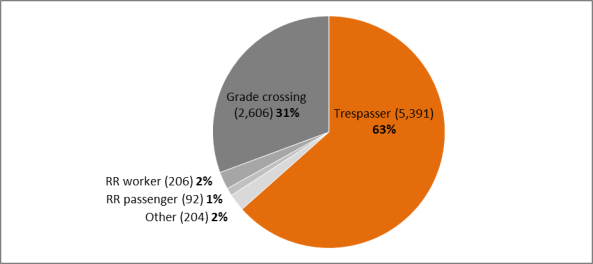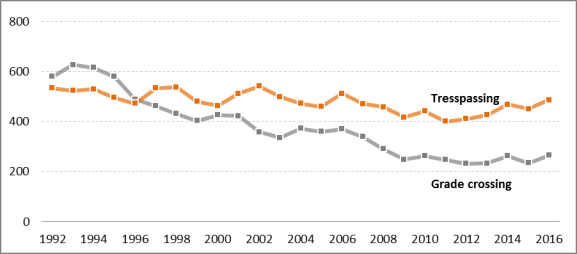Figure 1. Rail-Related Fatalities, 2005-2016
Excluding suicides

Source: CRS presentation of Federal Railroad Administration Safety Data (as of August 11, 2017); http://safetydata.fra.dot.gov/OfficeofSafety/Default.aspx.
Train derailments or collisions are often well-publicized events and receive significant attention from policymakers seeking to reduce their reoccurrence. Less attention has been devoted to trespassing, although it is a much greater cause of rail-related fatalities than derailments and collisions combined. Since 2005, over three-fifths of deaths in rail incidents have been pedestrian trespassers, and vehicle-train accidents at railroad grade crossings account for nearly one-third (see Figure 1; note that the trespassing deaths in the figure do not include suicides).
|
Figure 1. Rail-Related Fatalities, 2005-2016 Excluding suicides |
 |
|
Source: CRS presentation of Federal Railroad Administration Safety Data (as of August 11, 2017); http://safetydata.fra.dot.gov/OfficeofSafety/Default.aspx. |
In 2016, there were 485 trespasser deaths, 492 trespasser injuries, and 229 suicides on rail property. These figures are only for freight, commuter, and intercity passenger railroads, and exclude subways and light rail systems.
Efforts by railroads and government agencies have steadily reduced most types of rail-related fatalities in recent years. For example, the number of deaths in grade-crossing incidents fell from 698 in 1990 to 248 in 2009, although it has not continued to fall since then. In contrast, there has been no progress in reducing the number of deaths from pedestrian trespassing, which has been the leading cause of rail-related fatalities since 1997 (see Figure 2).
|
Figure 2. Trespassing and Grade-Crossing Fatalities Trespassing does not include suicides |
 |
|
Source: CRS presentation of Federal Railroad Administration Safety Data (as of August 11, 2017); http://safetydata.fra.dot.gov/OfficeofSafety/Default.aspx. |
Efforts to reduce grade-crossing deaths focus on education of an identifiable population—automobile drivers, particularly young drivers. Those killed while trespassing, on the other hand, are not an easily identifiable population subset. They are not clustered in any particular age group, although the majority are male. The most populous states (California, Texas, Illinois, and New York) generally also have the most deaths. The Federal Railroad Administration (FRA) has developed a location map of trespassing deaths and injuries from June 2011-October 2017.
Most pedestrian trespassers are simply taking a shortcut along rail tracks, although some are on the tracks for recreational purposes. The public may have the misperception that they will be able to hear a train coming in time to avoid it. Slightly more deaths occur in the warmer months. Although most fatal incidents involve trespassers walking on or beside the tracks, some victims are killed lying, standing, or sitting on or beside the tracks. The wearing of ear or headphones, distraction by cellphones, and alcohol or drugs are believed to play a role in many deaths. Trespassers may not appreciate that once an engineer sees them, it may take more than a mile for the train to stop.
Although the freight railroads, Amtrak, and many commuter railroads have police forces that could arrest trespassers, the industry has devoted most of its effort to educating the public that railroad tracks are far riskier than they appear. The rail industry and the U.S. Department of Transportation fund Operation Lifesaver, a national nonprofit organization that administers a public education program about grade-crossing safety and prevention of trespassing. It has a paid staff of five and relies on 2,000 volunteers (many of them current or retired railroad employees) to educate the public about the potential dangers of railroad rights-of-way. It has been found effective in reducing collisions at grade crossings.
At a National Transportation Safety Board (NTSB) forum on rail trespassing, panelists expressed the need for further research on trespassing activity in order to better identify the intended audience for education programs. It was noted that FRA collects data only on trespassing activity that results in a fatality or injury, while individual railroads may have much larger data sets of trespassing encounters that might yield more actionable information. At the forum, it was also noted that Hollywood often depicts rail trespassing as an acceptable or even attractive activity, and instead could be enlisted to warn of its dangers.
Education about the dangers of rail trespassing is part of a three-pronged ("3 E's") approach that also includes engineering (warning signs, fencing) and enforcement (policing, fines). Freight railroads seek to reduce trespassing because, among other reasons, a death or injury results in a crime scene investigation, delaying train movement. Police encounters with trespassers, supplemented with information from locomotive crews and perhaps locomotive-mounted cameras, can be used to identify trespassing "hot spots" and then evaluate abatement options. At the NTSB forum, a Los Angeles police official noted that Transportation Security Administration funding for surveillance and sensors along tracks had been helpful in identifying high-risk areas for trespassing.
Congress provided additional funds in FY2016 for new FRA trespass prevention managers to develop site-specific mitigation plans in each of FRA's regions. These plans would utilize lessons learned from two pilot tests: one in Pittsford, NY, indicating that surveillance equipment linked to automatic warnings can be effective in reducing the number of trespassing incidents, and one in West Palm Beach, FL, that validated a process for organizing local stakeholders in order to identify and implement mitigation measures. For FY2018, the House Appropriations Committee has asked FRA to develop a national strategy for preventing trespassing (H.Rept. 115-237). The FRA has compiled information on strategies to reduce trespassing for law enforcement and local communities.
Congress generally appropriates $1 million per year for Operation Lifesaver. (Operation Lifesaver also receives funding specific to grade-crossing safety through the Federal Highway Administration). However, there is no dedicated program devoted to rail trespass prevention analogous to the so-called "Section 130 program" (in Title 23 of the U.S. Code), which provides more than $200 million annually from the federal Highway Trust Fund for train warning devices and other safety improvements at rail grade crossings.